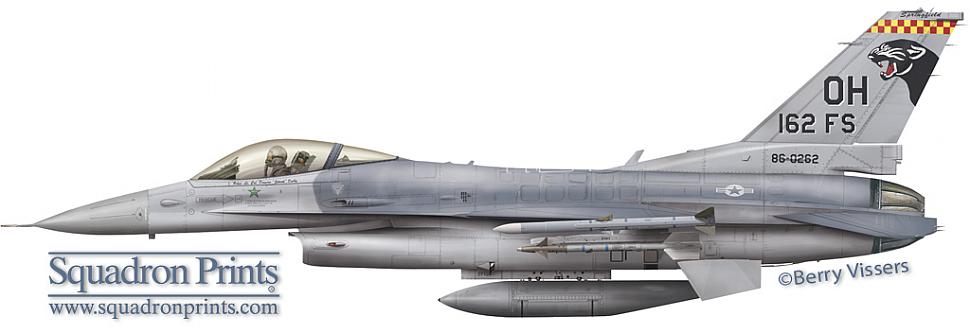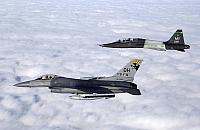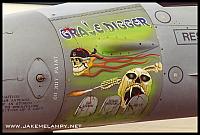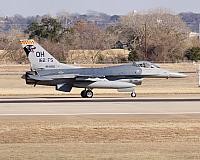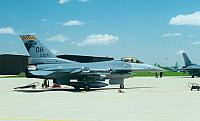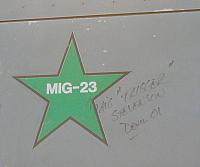 |
162nd Fighter Squadron ( USAF ANG)" Sabers" |
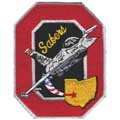 |
162 FS " Sabers" ( USAF ANG) | |||
| Status: |
Converted
|
|||
| Version: | F-16C/D block 30 (big mouth) | |||
| Role: | Training | |||
| Tailband: | Yellow & Red (checkerboard) | |||
| Motto: | N/A | |||
| Badge: | N/A | |||
|
Converted to the MQ-1 on June 10th, 2010.
|
||||
F-16 History
During May of 1993 the squadron marked the end of 15 years of A-7 operations with the 162nd Fighter Squadron. Later in the year the conversion to the F-16C big inlet was complete. In December of 1993 the squadron received F-16C #86-0262 which was an aircraft made famous earlier in the year with the 23rd Fighter Squadron when it was used to shoot down an Iraqi MiG-23 on January 17th, 1993 with an AMRAAM missile.
In June of 1995 the 162nd FS deployed to Denmark where they participated in exercises BALTOP 95 and CENTRAL ENTERPRISE. The 162nd provided RED AIR for the BALTOP exercise and flew 225 sorties in CENTRAL ENTERPRISE with eight aircraft.
In 1997 the squadron celebrated its 50th anniversary and painted aircraft #86-0216 with special markings on the tail. The aircraft was rarely seen in public with its special paint scheme which was quickly painted in a standard scheme by year end.
In 1998 it was announced that the squadron would become a dedicated training squadron. An ANG unit under the control of the AETC. The squadron would be tasked with training active duty, guard and reserve F-16 pilots as an Advanced Flight Training Unit. In late 1998 F-16Ds #87-0386 and #88-0151 were added to the squadron and then in 1999 a few more F-16D's #86-0050, #87-0367, #87-0370 and #87-0373 arrived at Springfield completing the extra two seater F-16s needed for pilot training.
Beginning in September of 2000, the 162nd FS officially changed rolls and began training pilots. The squadron kept the block 30s with the General Electric engines which was unusual in the AETC community. Courses includes the Basic Course, or also known as the B-course, which is for students who have never flown a fighter aircraft, but are graduates of Air Force Undergraduate Pilot Training. Students are put through an 8.5 month training module. This includes in class time, simulator training and in-flight training.
Under the 2005 Base Closure and Realignment Commission (BRAC), a decision came down that the parent 178th Fighter Wing would lose its F-16s and ultimately convert to a drone squadron. The Springfield aircraft would be distributed to ANG units. It was later revealed that the decision may have been a mistake as the 2005 BRAC decision did not take into account that the 162nd FS was indeed a training squadron.
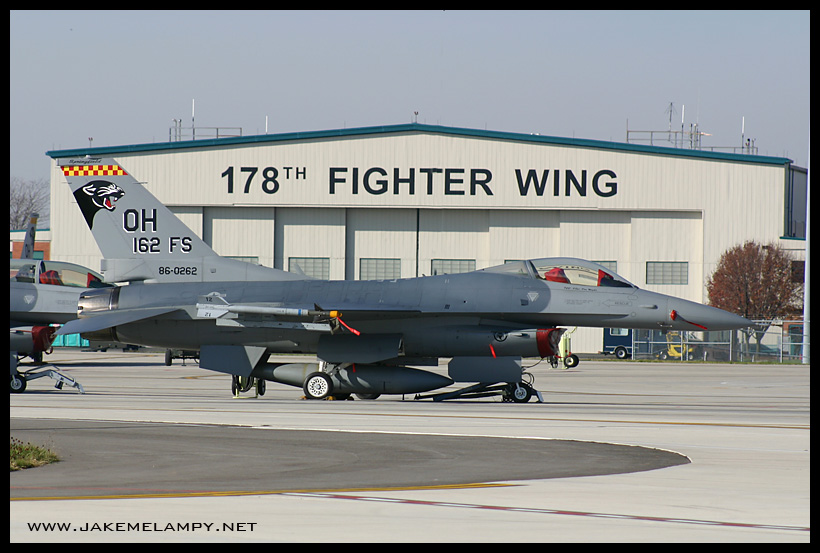
In April of 2007 the Dutch 306 Detachment from Tucson, Arizona moved to Springfield to provide a different training environment. The detachment was not associated directly to the 162nd FS. However the Springfield facilities were F-16 ready so as a result, when the 162nd FS shut down their F-16 operations, the Dutch detachment would leave shortly after. The current RNlAF training mission at Springfield ANGB ends in 2010 with the unit to head back for Arizona. About 6 classes graduated out of the Dutch detachment while at Springfield.
The 162nd FS graduated its final American F-16 Basic Course class on December 12th, 2009. The class had started on March 30th, 2009. In the squadron's tenure, as a training squadron, a total 77 pilots went through the B-course. Another 273 people went for pilots upgrading to operational or formal training instructor pilot. This makes a total of 350 pilots that have taken any pilot training at Springfield.
Just prior to the squadron closing out Viper operations, on April 22nd, 2010 the squadron had a more unique deployment in Hungary. The fifteen day deployment allowed USAF F-16s to fly with Hungarian AF Gripens, MiG-29s and the Mi-24s. The American pilots and Hungarian AF pilots had the opportunity to engage in various air-to-air scenarios.
For the 162nd FS the final sortie was on July 30th, 2010. To celebrate the squadron's history, F-16C #86-0364 was painted up in special markings and incorporated some markings from the famous Second World War P-51 Mustang 'Old Crow'. On the last flight four of the most senior pilots in the squadron with the most hours in the F-16 flew. The four pilots had a combined 100 years in fighters and topped out at 15,920 hours in fighters with 12,380 of those hours in the Viper.
Although the last sortie had been a few months earlier, the last American aircraft departed Springfield on September 20th, 2010. This ended the manned flying mission of the 162nd FS. The Dutch detachment was scheduled to return to Tucson, Arizona by January of 2011. Instead they pulled out early and were gone from Springfield by November 15th, 2010 when the last Dutch F-16 departed.
Conversion to the MQ-1 began in 2010. The mission will be under the control of the Air Combat Command. This will consist of four intell squadrons. Pilots based in Springfield will be able to fly MQ-1s on the other side of the world in Iraq or Afghanistan. A second component works under the National Air and Space Intelligence Center (NASIC).
Aircraft Markings History
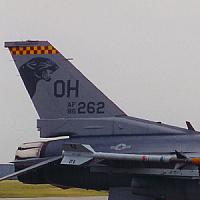
Markings consist of the 'OH' tailcode and a red and yellow checkerboard tailband with the name 'Springfield' in small cursive writing about the band. A large image of a Saber head gives the tail a more dramatic unique appearance.
Unit History
- 1942: Activation of the squadron in Hamilton, California (as 362 FS)
- 1942: P-39 'Airacobra' (part of 357 FG)
- 1943: P-51D 'Mustang' (European theatre)
- 1946: Disbanded
- 1947: Activation of the squadron in Cox-Dayton, Ohio
- 1947: P-51D 'Mustang'
- 1950: F-51H 'Mustang'
- 1955: F-84E 'Thunderjet'
- 1957: F-84E 'Thunderjet' (Springfield MAP, Ohio)
- 1958: F-84F 'Thunderstreak'
- 1962: F-84F 'Thunderstreak' (part of 178 TFG)
- 1970: F-100D/F 'Super Sabre'
- 1978: A-7D 'Corsair II'
- 1992: A-7D 'Corsair II' (part of 178 FG)
- 1993: F-16C/D 'Fighting Falcon'
- 1995: F-16C/D 'Fighting Falcon' (part of 178 FW)
- 2010: Converted
Deployments
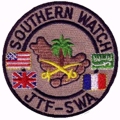 |
' Southern Watch' |
| Prince Sultan AB, Saudi Arabia (August of 1996 to October of 1996) | |
| Operation Southern Watch was an operation which was responsible for enforcing the United Nations mandated no-fly zone below the 32nd parallel in Iraq. This mission was initiated mainly to cover for attacks of Iraqi forces on the Iraqi Shi’ite Muslims. | |
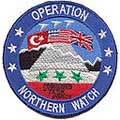 |
' Northern Watch' |
| Incirlik AB, Turkey (June of 1997 to August of 1997) | |
| Operation Northern Watch was a US European Command Combined Task Force (CTF) who was responsible for enforcing the United Nations mandated no-fly zone above the 36th parallel in Iraq. This mission was a successor to Operation Provide Comfort which also entailed support for the Iraqi Kurds. |
F-16 Airframe Inventory
- All 162 FS F-16s in our F-16 Aircraft Database (past and current aircraft)
- Current 162 FS F-16s in our F-16 Aircraft Database
Photos
Please use this form to add any list any error or omissions you find in the above text.
Note: your comments will be displayed immediately on this page. If you wish to send a private comment to the webmasters, please use the Contact Us link.

